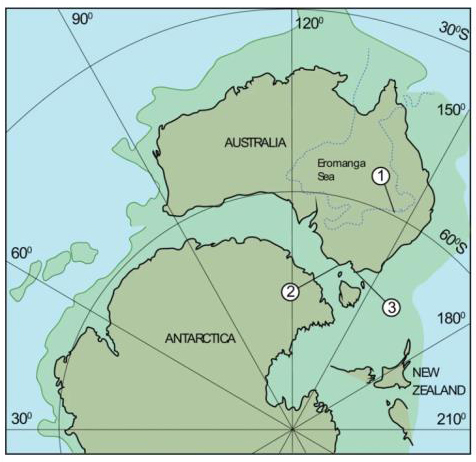Dinosaurs Bred Close to the South Pole
Baby Dinosaurs from Australia Indicate Dinosaurs Bred at High Latitudes in the Southern Hemisphere
Evidence has been found of ornithopod dinosaurs breeding at high latitudes in the Northern Hemisphere but evidence of similar behaviours in the Southern Hemisphere, dinosaurs nesting within the Antarctic Circle, had been lacking until now.
Writing in the on-line, open access journal “Scientific Reports”, researchers from the University of New England (New South Wales, Australia), in collaboration with colleagues from the Australian Opal Centre (Lightning Ridge, New South Wales), report the discovery of two tiny thigh bones (femora), that suggest that ornithopods did breed in southern polar environments.
An Artist’s Reconstruction of a Nesting Ornithopod with Recently Hatched Young

Picture credit: James Kuether
Co-author of the scientific paper, Dr Phil Bell (School of Environmental and Rural Science, University of New England) explained:
“We have examples of hatchling-sized dinosaurs from close to the North Pole, but this is the first time we’ve seen this kind of thing anywhere in the southern hemisphere. It’s the first clue we’ve had about where these animals were breeding and raising their young.”
Dinosaurs Were Able to Tolerate a Range of Climates
The discovery of the two tiny, opalised thigh bones adds to the growing body of evidence that suggests that the Dinosauria, just like their close relatives the birds, were remarkably climate-tolerant. They thrived in equatorial, temperate and polar environments.
Fossilised eggshell and the fossilised remains of tiny hatchling hadrosaurids demonstrates that dinosaurs bred at high latitudes in the Northern Hemisphere and now the discovery to two partial thigh bones from the Griman Creek Formation exposed near Lightning Ridge suggests that non-iguanodontid ornithopods bred beyond sixty degrees south, well inside the Antarctic Circle.
The Two Opalised Fragmentary Dinosaur Thigh Bones (Femora)

Picture credit: Scientific Reports
The two fragmentary fossil femurs do not preserve any evidence of histology, so, it is not possible to determine the exact age of the animals from these fossils. However, when this material is compared with neonatal and slightly older, possible yearling specimens known from the geologically slightly older Eumeralla and Wonthaggi formations in Victoria (Australia), it can be deduced that these are the thigh bones of embryonic dinosaurs, ones that were yet to hatch.
The femur is relatively large (although in these tiny dinosaurs, one femur is estimated to have a total length of 4.5 cm, whilst the other is even smaller with an estimated total length of just 3.7 cm), as such, this bone has a better chance of surviving the fossilisation process than most of the other bones in the dinosaur’s body.
Permanent Residents
Palaeontologists had thought that dinosaurs living at high latitudes were not permanent residents, they migrated into these areas during the period of extended daylight and subsequent copious plant growth, just like herds of caribou in the Arctic Circle do today. However, the ornithopods, even as fully grown adults were relatively small animals, as such they were probably not capable of migrating vast distances. Therefore, it is likely that at least some dinosaurs were permanent residents at very high southerly latitudes and as such they bred at these environments.
Palaeogeographic Map of Australia Around 100 Million Years Ago

Picture credit: Scientific Reports
The image (above) shows the approximate landmass associated with the polar regions around 100 million years ago. The tiny fossilised thigh bones come from (1) the Lightning Ridge location. In order to determine the age of these dinosaurs, they were compared with bones representing neonatal and slightly older animals found at locations (2) and (3).
The researchers conclude that these fossils support they hypothesis that some dinosaurs at least were permanent residents in the very southernmost portion of Gondwana.
The scientific paper: “High-latitude neonate and perinate ornithopods from the mid-Cretaceous of south-eastern Australia” by Justin L. Kitchener, Nicolás E. Campione, Elizabeth T. Smith and Phil R. Bell published in Scientific Reports.
View the Everything Dinosaur website: Everything Dinosaur.

